How to Solve the Producer-Consumer Problem in Java using Multithreading

[ad_1]
Concurrency is an important part of Java applications. Each application has multiple processes running at the same time. This helps utilize resources efficiently and improve performance.
Multithreading is a method of achieving concurrency. It uses the concept of threads – lightweight processes – to execute multiple tasks in parallel. A very popular application of multithreading is the producer-consumer problem.
In this tutorial, we are going to understand what the producer-consumer problem is and touch upon threads and multithreading briefly. Then, we are going to understand how to solve the producer-consumer problem in Java using threads.
Now, I assume you have a basic knowledge of Java. If not, then check out the following resources.
Table of Contents
What is the Producer-Consumer Problem?
The producer-consumer problem is a synchronization problem between different processes. There are three entities in this problem: a producer, a consumer, and a memory buffer. Both the producer and consumer share the same memory buffer.
The producer produces some items and pushes them into the memory buffer. A consumer then consumes these items by popping them out of the buffer. If the buffer is empty, then the consumer waits for the producer to push an item, which it consumes after the producer pushes it.
The memory buffer is of fixed size. If it is full, the producer waits for the consumer to consume an item before pushing a new one. The producer and consumer cannot access the buffer at the same time – that is, it’s mutually exclusive. Each process should wait for the other to finish its work on the buffer before it can access the buffer.
Operating systems often encounter this problem where multiple processes access the same memory space to perform their tasks.
We will solve this problem using multithreading, so I assume you have a basic idea about what multithreading is and how it works. If not, then you can read through this tutorial.
We’ll start with an attempt to solve it simply using threads and a separate class for message queue. Then, we’ll understand its issues and how to overcome them in the next approach. We’ll also see other approaches to the problem. Make sure to stick around until the end.
Solution using Producer and Consumer Threads
Let’s go over our requirements first.
- Producer and Consumer tasks run in separate threads
- Common data bus, typically a message queue, used by both producer and consumer.
- If not full, producer pushes data into queue, or waits for it to be consumed
- If not empty, consumer takes data out of the queue, or waits for producer to publish.
These are the things we need to implement to solve this problem. Let’s create the message queue first.
Message Queue
To set up a message queue, we’ll use a class that contains the queue and methods to publish and consume messages.
class Data {
Queue<String> q;
int capacity;
Data(int cap) {
q = new LinkedList<>();
capacity=cap;
}
// other methods
}Here, we have used Java’s Queue class to store our messages. Each message is of type String. But in bigger applications, the message or payload could be of any object type. We also define the capacity of the message queue.
Next, we’ll implement the publish() method. The method accepts a new message to be published.
public void publish(String msg) { // publish message to the queue }
First, we check if the queue is full. We can’t publish a new message if the queue has reached capacity.
if(q.size() == capacity){
return;
} If the queue is not full, then add the message to the queue.
q.add(msg); We’ll add print statements to understand the workflow better.
public void publish(String msg) {
String name=Thread.currentThread().getName();
if(q.size() == capacity){
System.out.println("Queue Full!"+name+" waiting for message to be consumed...");
return;
}
q.add(msg);
System.out.println("Message published:: "+msg);
System.out.println("Queue: "+ q);
System.out.println();
}Here, we just print the thread that is inside the method, the message published, and the resulting queue.
Let’s implement the consume() method now. This method does not take any arguments and works similarly to the publish() method. We first check if the queue is empty, before removing anything from the queue.
if(q.size()==0){
return;
}Then, we remove the message.
q.poll();
Again, we’ll add print statements to understand the workflow better.
public void consume() {
String name=Thread.currentThread().getName();
if(q.size()==0){
System.out.println(name+" waiting for new message...");
return;
}
String msg = q.poll();
System.out.println(name+" has consumed msg:: "+msg);
System.out.println("Queue: "+ q);
System.out.println();
}Producer Thread
Let’s write the producer logic now. We’ll create a class Producer that will run in a thread. There are several ways to create threads in Java. We’ll use the Runnable interface to create our thread since it’s the most preferred approach.
class Producer implements Runnable{
Data data;
public Producer(Data data) {
this.data = data;
}
@Override public void run() { }
}The producer has access to the data bus object which is passed to it via the constructor. The producer logic goes inside the run() method. By overriding the run method, you are writing functionality that runs in a thread.
Now, a producer’s ways of producing and publishing data differs in every application. For this post, we are going to simulate a functionality where the producer keeps publishing messages every few seconds.
We’ll define a list of messages that the producer can use.
final String[] messages={"Hi!!", "How are you!!", "I love you!", "What's going on?!!", "That's really funny!!"}; Here’s the producer logic inside the run() method:
public void run() {
int i=0;
try {
while(true){
Thread.sleep(1000);
data.publish(messages[i]);
i=(i+1)%messages.length;
}
} catch (InterruptedException e) {}
}In this code, the producer is publishing a message from the messages list every 1000 ms. Thread.sleep(some_delay) pauses execution of the thread for a certain period. Since it throws an exception, we surround the code with a try-catch block.
This is just for demonstration purposes – don’t worry about the logic. Our implementation works regardless of the producer or consumer logic.
Consumer Thread
Similar to producer thread, let’s simulate the consumer logic.
class Consumer implements Runnable{
Data data;
public Consumer(Data data) {
this.data = data;
}
@Override public void run() {
try {
while(true){
Thread.sleep(2000);
data.consume();
}
} catch (InterruptedException e) {}
}
}Here, the consumer tries to consume a message every 2000 ms.
Putting it all Together
Now, we have our message queue along with the producer and consumer classes. Let’s create one producer and one consumer thread and start them.
We’ll create a Data object with capacity of 5 messages and create our producer and consumer threads with the objects of the Producer and Consumer classes.
public class Main {
public static void main(String[] args) {
Data data = new Data(5);
Thread producer=new Thread(new Producer(data), "producer");
Thread consumer=new Thread(new Consumer(data), "consumer");
producer.start();
consumer.start();
}
}The run() method executes in a separate thread when start() is called.
Output:
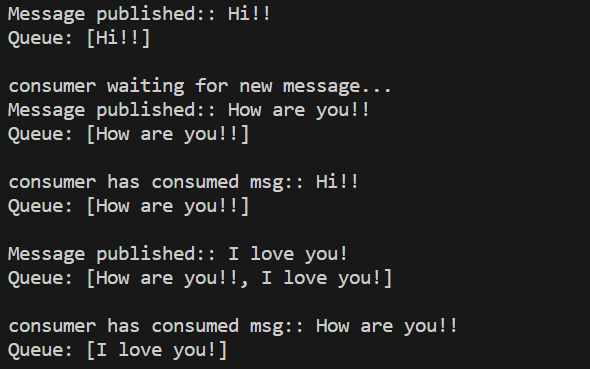
Here, the output is inconsistent with the desired workflow. Even after publishing the first message, the consumer is still waiting. Then, a consumer has consumed a message Hi!! that doesn’t exist. The state of the queue is also inconsistent.
You will probably get a different output, since thread execution depends on the core OS. But the issue still persists. Why does this happen?
Synchronization Issue With the Data Class
Both producer and consumer threads run simultaneously, working on the same resource. They are accessing the message queue at the exact same time. Both the threads may start with one version of the resource and by the time they perform an operation, they are working on a different version.
This leads to a race condition. Both threads end up competing for the same resource and give inconsistent results. The producer thread is trying to add a message to the queue, while at the same time a consumer is trying to consume a message. There’s no way of controlling which message the consumer could get.
To solve this issue, we need some kind of mechanism to ensure that only one thread can operate on a shared resource at a time. In this case, we’ll use the concept of synchronization.
At a glance, a synchronized function or a block can only be executed by one thread at a time. A thread entering such a block acquires a “lock” on the object and any other threads have to wait until the thread releases this lock – that is, until it finishes working on the shared resource.
We’ll use a similar method to solve our issue.
Introducing Synchronization in the Message Queue
To ensure the message queue is only accessed by one thread (producer or consumer) at a time, a thread needs to secure a lock on the Data object before performing any operations.
How to Use the synchronized Keyword
An object can be made mutually exclusive by using the synchronized keyword. We’ll use the synchronized keyword with the publish() and consume() methods.
public synchronized void publish(String msg) public synchronized void consume()
Now, a thread needs to acquire a lock on the object before entering these methods.
What are the wait() and notify() Methods?
We have achieved synchronization – only one thread can access a shared resource at a time to ensure consistency. Now, we need to establish communication between the producer and consumer threads.
Let’s understand what we need first. If the queue is full, the producer needs to wait for a consumer to consume an item. Similarly, if the queue is empty, the consumer needs to wait until the producer pushes an item.
Also, when a producer pushes an item, it needs to notify all the waiting consumer threads about the action. The is also true when the consumer consumes an item. So, how do we establish this communication?
We can do this using the wait() and notify() methods. When the wait() method is called, the thread releases the lock on the object and enters a waiting state until another thread calls the notify() or notifyAll() method.
notify() wakes up one thread that is in the waiting state, while notifyAll() wakes up all waiting threads. When a thread wakes up again, it has to re-acquire the lock on the object. If another thread has the lock, then this thread needs to wait until the other thread releases the lock.
You can learn more about the wait() and notify() methods here.
How to Communicate Between Threads using wait() and notify()
Let’s use the above methods. A producer needs to wait before it pushes an item if the queue is full. So, invoke the wait() method if the queue is at capacity. Similarly, the consumer needs to wait if the queue is empty.
To wake up threads from the waiting state, call notifyAll() after the producer publishes a message and the consumer consumer a message. This will notify all the waiting threads.
Here is the updated publish() method:
public synchronized void publish(String msg) throws InterruptedException {
String name=Thread.currentThread().getName();
if(q.size() == capacity){
System.out.println("Queue Full!"+name+" waiting for message to be consumed...");
wait();
}
q.add(msg);
System.out.println("Message published:: "+msg);
System.out.println("Queue: "+ q);
System.out.println();
notifyAll();
}And here’s the updated consume() method:
public synchronized void consume() throws InterruptedException {
String name=Thread.currentThread().getName();
if(q.size()==0){
System.out.println(name+" waiting for new message...");
wait();
}
String msg = q.poll();
System.out.println(name+" has consumed msg:: "+msg);
System.out.println("Queue: "+ q);
System.out.println();
notifyAll();
}wait() and notify() can throw InterruptedException, so we add a throws declaration to the methods.
Output:
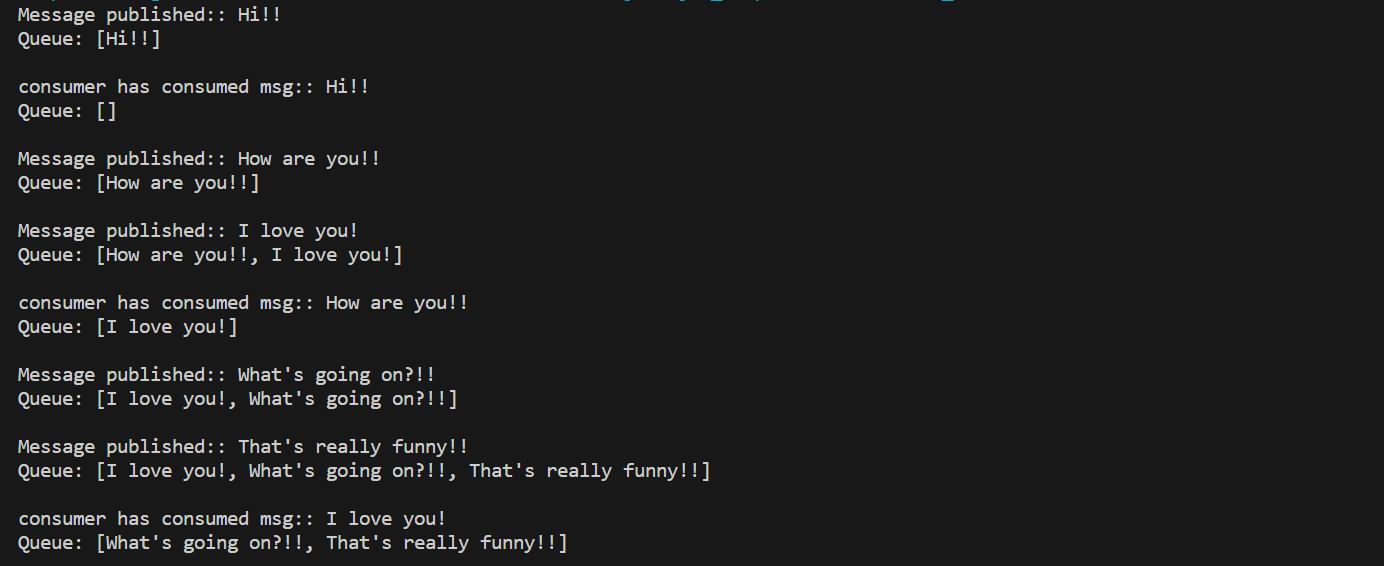
This time, the output is more consistent and we are getting the expected behavior. The producer keeps publishing messages and the consumer consumes those messages.

Here, the queue is full and the producer waits for the consumer to consume a message. Only after that does the producer publish a new message.
Producer with Multiple Consumers
So far, we have tackled the problem with one producer and one consumer. In a real-world application, there could be multiple producers and consumers, all of them running in separate threads.
Let’s add more consumer threads to see how we could handle this scenario:
for(int i=1;i<=5;i++){
new Thread(new Consumer(data), "Consumer "+i).start();
}Here, we have created 5 consumer threads, labelled them, and started them one by one. But, this is not enough. There is an issue with the existing approach.
Let’s reduce the consumer sleep time and run the code:
Thread.sleep(500);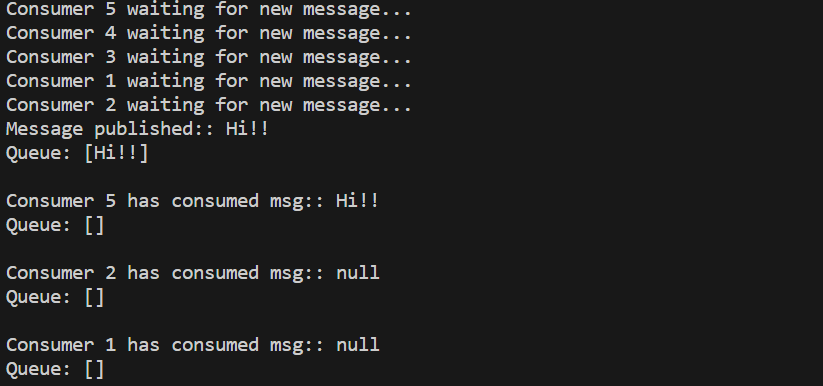
Here, after consumer 5 has consumed a message, the other consumers are able to consume even if the queue is empty.
The issue lies in the following condition:
if(q.size()==0){
wait();
}Let’s understand the workflow first. Consider Consumer 5 (C5) and Consumer 1 (C1). C5 secures the lock on the method and enters it. The queue is initially empty, so it releases the lock and waits for the producer. At the same time, C1 secures the lock and enters the method. It also waits for the producer.
So, C5 and C1 are waiting. The producer publishes a message. C5 and C1 are notified and they wake up. C5 reacquires the lock and proceeds to consume the message, while C1 waits for C5 to release the lock. Here, C1 is not waiting because of wait() – it has woken up and now it’s waiting at the next line.
After C5 consumes the message and releases the lock, C1 continues and tries to consume the message. But the queue is empty now, so it receives null or throws an exception. This also happens with the other threads.
To prevent this, we need to check if the queue is empty once again. So, instead of using an if condition, we use a while loop like this:
while(q.size()==0){
wait();
}This checks if the queue is empty every time a thread wakes up. So, if multiple threads wake up at the same time, it should check if another thread has emptied the queue.
We do the same for checking if the queue is full.
while(q.size() == capacity){
wait();
}This time, the code runs without any issues.
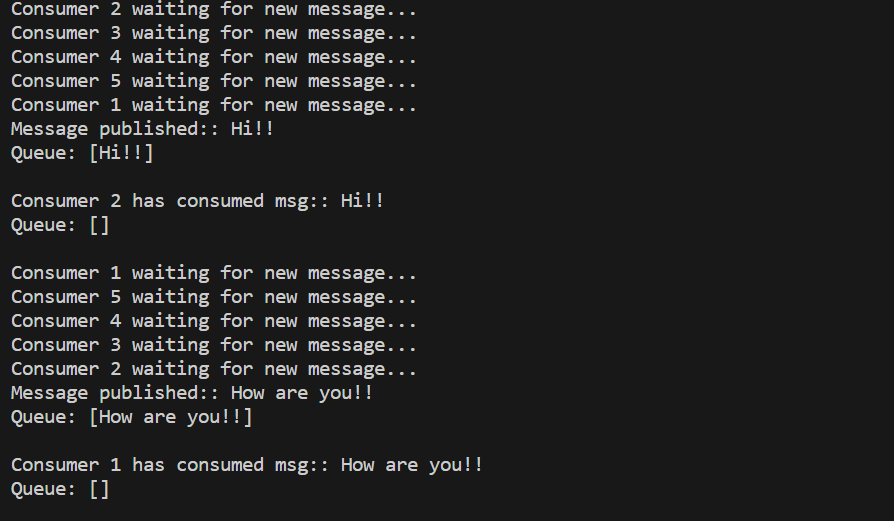
Here is the complete code for Data class:
class Data {
Queue<String> q;
int capacity;
Data(int cap) {
q = new LinkedList<>();
capacity=cap;
}
public synchronized void publish(String msg) throws InterruptedException {
String name=Thread.currentThread().getName();
while(q.size() == capacity){
System.out.println("Queue Full!"+name+" waiting for message to be consumed...");
wait();
}
q.add(msg);
System.out.println("Message published:: "+msg);
System.out.println("Queue: "+ q);
System.out.println();
notifyAll();
}
public synchronized void consume() throws InterruptedException {
String name=Thread.currentThread().getName();
while(q.size()==0){
System.out.println(name+" waiting for new message...");
wait();
}
String msg = q.poll();
System.out.println(name+" has consumed msg:: "+msg);
System.out.println("Queue: "+ q);
System.out.println();
notifyAll();
}
}You can create any number of producers and consumers and test this code in multiple scenarios.
Solution using Java Concurrency’s BlockingQueue Class
So far you have learned what the producer-consumer problem is and how it can be solved. But, while working on real-time applications, we probably won’t implement synchronization manually.
Instead, we can use the BlockingQueue class from java.util.concurrent package. The difference between Queue and BlockingQueue is that it waits for the queue to become non-empty before a message can be consumed. Similarly, it waits for the queue to have space before publishing a new message.
We can initialize the blocking queue in the following way:
BlockingQueue<String> q = new ArrayBlockingQueue<>(10);This creates a blocking queue of capacity 10. To publish an item, we use the put() method, and to remove an item, we use the take() method.
Let’s first use this in our Producer class:
class Producer implements Runnable{
BlockingQueue<String> q;
final String[] messages={"Hi!!", "How are you!!", "I love you!", "What's going on?!!", "That's really funny!!"};
public Producer(BlockingQueue<String> q) {
this.q = q;
}
@Override
public void run() {
int i=0;
try {
while(true){
Thread.sleep(500);
q.put(messages[i]);
System.out.println("Message published:: "+messages[i]);
i=(i+1)%messages.length;
}
} catch (InterruptedException e) {}
}
}Here, we are not using a separate Data class with synchronized methods, since the put() and take() methods of BlockingQueue are synchronized. Here, if the queue is full, the put() method waits for a consumer to consume a message.
Similarly, let’s update our Consumer class:
class Consumer implements Runnable{
BlockingQueue<String> q;
public Consumer(BlockingQueue<String> q) {
this.q = q;
}
@Override
public void run() {
try {
while(true){
Thread.sleep(1500);
String msg=q.take();
String name=Thread.currentThread().getName();
System.out.println(name+" has consumed msg:: "+msg);
}
} catch (InterruptedException e) {}
}
}Here, if the queue is empty, the take() method waits for the producer to publish a message.
Let’s create our BlockingQueue object and start these threads:
public class Main {
public static void main(String[] args) {
BlockingQueue<String> q = new ArrayBlockingQueue<>(10);
Thread producer = new Thread(new Producer(q));
producer.start();
for(int i=1;i<=5;i++){
new Thread(new Consumer(q), "Consumer "+i).start();
}
}
}Here, we have one producer thread and 5 consumer threads. Let’s see the output:
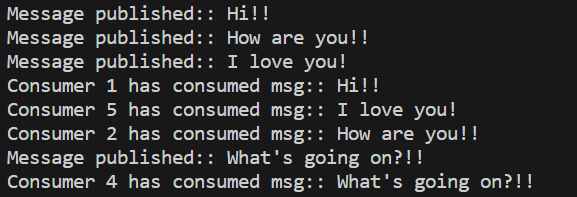
In the output, you can see that after consumers 1, 3, and 2 have consumed a message, the other consumers wait for a message to be published before consuming it.
There could be a few inconsistencies while printing these messages since the thread only stops at the put() or take() methods and not the println() statements. But the code runs properly. Again, the output will be different each time you run the code.
So, while working on big projects, you can use the BlockingQueue class. But it’s important to understand how to deal with the whole producer-consumer problem from scratch. This is really helpful, especially during interviews, since you typically won’t be allowed to use the BlockingQueue class.
Conclusion
In this tutorial, you learned about an important problem in concurrency, the product-consumer problem. And you learned how you can solve it using multithreading in Java.
In total, we implemented four different approaches:
First, I started out with a very basic and straightforward implementation. Running the producer and consumer in separate threads helped achieve concurrency. But since they used the same message queue, there was a synchronization problem.
Therefore, in the next approach, we added synchronization to fix the issue. Then, we added more consumers who would all wait for the producer. There, we learned why it is important to check the full and empty conditions every time a thread wakes up.
After going through the whole implementation from scratch, we saw a simple way to solve the Producer-Consumer problem in Java using BlockingQueue. By understanding different approaches and their issues, you can get a better idea of how to tackle a problem. I hope this guide helps with your future endeavors.
If you are unable to understand the content or find the explanation unsatisfactory, let me know. New ideas are always appreciated! Feel free to connect with me on Twitter. Till then, goodbye!
[ad_2]
Source link
